SOLUTIONS TO PROBLEMS
CHAPTER 1
Linear Equations
Section 1.1 Introduction to algebra
Practice Problems
1. (a) −30 (b) 2 (c) −5
(d) 5 (e) 36 (f) −1
2. (a) −1 (b) −7 (c) 5
(d) 0 (e) −91 (f) −5
3. (a) 19 (b) 1500 (c) 32
(d) 35
4. (a) 9 xy + (b) 24yz +
(c) not possible
(d) 8322 rsrss ++− (e) 4 f
(f) not possible (g) 0
5. (a) 5z − 2z 2
(b) 6x − 6y + 3y − 6x = −3y
(c) x − y + z − x 2 − x + y = z − x 2
6. (a) 7(3) d + (b) 4(45) wq
(c) 3(23) xyz −+ (d) 5(12) QQ
7. (a) x 2 − 2x + 3x − 6 = x 2 + x – 6
(b) x 2 − xy + yx − y 2 = x 2 − y 2
(c) x 2 + xy + yx + y 2 = x 2 + 2xy + y 2
© Pearson Education Limited 2018
4
(d) 5x 2 − 5xy + 5x + 2yx − 2y 2 + 2y = 5x 2 − 3xy + 5x − 2y 2 + 2y
8. (a) (x + 8) (x – 8)
(b) (2x + 9) (2x − 9)
Exercise 1.1 (p. 18)
1. (a) 20 (b) 3 (c) 4 (d) 1
(e) 12 (f) 50 (g) 5 (h) 3
(i) 30 (j) 4.
2. (a) 1 (b) 3 (c) 11 (d) 16
(e) 1 (f) 13 (g) 11 (h) 0
(i) 31 (j) 2
3. (a) 3 (b) 2 (c) 18 (d) 15
(e) 41 (f) 3 (g) 18 (h) 6
(i) 25 (j) 6
4. (a) 2 PQ (b) 8I (c) 3xy (d) 4 qwz
(e) 2 b (f) 2 3k
5. (a) 19 w (b) 47xy (c) 922abc +−
(d) 2 2 xx + (e) 43ccd (f) 22 29 stst+++
6. (a) 10 (b) 18 (c) 2000
(d) 96 (e) 70
7. (a) 1 (b) 5 (c) 6 (d) −6
(e) 30 (f) 44
8. (a) 16
(b) Presented with the calculation, −42, your calculator uses BIDMAS, so squares first to get 16 and then subtracts from zero to give a final answer, −16. To obtain the correct answer you need to use brackets:
© Pearson Education Limited 2018
Jacques, Mathematics for Economics and Business, 9e, Instructor’s Manual 5
17. 1.230001000(21);$204000SNEA =++−
Section 1.2 Further algebra
Jacques, Mathematics for Economics and Business, 9e, Instructor’s Manual 6 © Pearson Education Limited 2018 ( - 4 ) x 2 = 9. (a) 9 (b) 21 no. 10. (a) 43.96 (b) 1.13 (c) 10.34 (d) 0.17 (e) 27.38 (f) 3.72 (g) 62.70 (h) 2.39 11. (a) 77xy (b) 156xy (c) 412 x + (d) 217 x (e) 333 xyz ++ (f) 2 34xx (g) 2262254 yzxyzxyz +−−+=−−+ 12. (a) 5(56) c + (b) 9(2) x (c) (2)xx + (d) 4(43) xy (e) 2(23) xxy (f) 5(2310) de−+ 13. (a) 2 710xx++ (b) 2 34aa+− (c) 2 524dd (d) 2 62321 ss++ (e) 2 253 yy++ (f) 2 103114 tt (g) 2 94 n (h) 22 2 aabb −+ 14. (a) 62xy + (b) 2 1133 xx (c) 142 xyx + (d) 62 xyzxy + (e) 102ab (f) 1722xy + (g) 113 p (h) 2 10 xx + 15. (a) (2)(2) xx+− (b) (7)(7) QQ+− (c) ()() xyxy +− (d) (310)(310) xyxy +− 16. (a) 2 482 xx+− (b) 22 3231513 xxxxx +−−=−
18. (a) 8060 CLK =++ (b) 101.25 Cx =+ (c) 510 Hab =+ (d) XCdcm =+
Practice Problems 1. (a) 3 5 (b) 4 5 (c) 1 2 y (d) 1 23x + (e) 1 4 x
2. (a) 13133 24248 × ×== ×
(b) 717 144 ×=
(c) 13 14
28293 39384 ÷=×=
(d) 1 881 16 99 16 / ÷=× 2
3. (a) 312 777 −=
1 18 =
(b) 125611 35151515 +=+=
(c) 711495 184363636 −=−=
4. (a) 5 1 x 1 x × 5 22xx = ++
(b) 22 1(1) 1011010 xxxxxx xxxxx ++ ÷=×= ++++
(c) 41415 1111xxxx + +== ++++
(d) 21 12xx++ 2(2)(1)(1)
(1)(2)(1)(2)
(24)(1)(3)
++ =− ++++ +−++ == ++++
(1)(2)(1)(2)
xx xxxx xxx xxxx
5. (a) 4125 x += 424 x = (subtract 1 from both sides)
6 x = (divide both sides by 4)
© Pearson Education Limited 2018
7
Jacques, Mathematics for Economics and Business, 9e, Instructor’s Manual
(b) 4557
xx xx x =−
+=−
57 (subtract 4 from both sides)
=
962210 xx −+−= (multiply out brackets)
7410 x −= (collect like terms)
43 x −= (subtract 7 from both sides)
3 4 x =− (divide both sides by −4)
(d) 4 5 1 x =
45(1)(multiplybothsidesby1)
455(multiplyoutbrackets)
95(add5tobothsides)
9 (dividebothsidesby5)
= =
3(1)5(cross-multiplication)
335(multiplyoutbrackets)
xx xx xx x −= −= −= −=
3 (dividebothsideby2) 2
(c) 3 > 0 (true) (d) same as (c)
(e) 2 > 1 (true) (f) −24 > −12 (false)
(g) −6 > −3 (false) (h) −2 > −1 (false)
(i) −4 > −7 (true).
7. (a) 2x < 3x + 7
x < 7 (subtract 3x from both sides)
x > −7 (divide both sides by −1 changing sense because −1 < 0)
© Pearson Education Limited 2018
Jacques, Mathematics for Economics and Business, 9e, Instructor’s Manual 8
12 (add 7 to both sides)
(c) 3(32)2(1)10 xx −+−=
5 xx x x x =−− =−
(e) 35 1 xx =
32(subtract3frombothsides)
6. (a) 12 > 9 (true) (b) 12 > 6 (true)
(b) 2119415 xx−≥+
171915 x −≥ (subtract 4x from both sides)
17x ≥ 34 (add 19 to both sides)
x ≥ 2 (divide both sides by 17, leaving inequality unchanged because 17 > 0) Exercise 1.2 (p.
36)
5.
; 222(1)2 xx xx
other two have no common factors on top and bottom.
© Pearson Education Limited 2018
Jacques,
9e,
9
Mathematics for Economics and Business,
Instructor’s Manual
1. (a) 1 2 (b) 3 4 (c) 3 5 (d) 1 3 (e) 41 1 33 = 2. (a) 357 10020 = ; 5614 10025 = (b) 563 1 355 = 3. (a) 2 3 x (b) 1 2 x (c) 1 ac (d) 2 3 x y (e) 3 4 a b .
(a) 2 2(23)23 pp qrqr = ++ (b) 1 (4)4 x xxx = (c) 3 3(21)21 abb aaa = ++
142 7(3)3 d dee = (e) 21 (using the difference of
(2)(2)2 squares for the denominator) x xxx + = +−−
4.
(d)
two
6. (a) 3 7 (b) 1 3 (c) 325 666 += (d) 1587 202020 −= (e) 347 181818 += (f) 145 666 += (g) 1 2 535 648 / ×= / (h) 21 51 432 1525 / / ×= // / (i) 1 4 727 8312 / ×= / (j) 11 152 251 75430 / / ×= / // (k) 212 9327 ×= (l) 37211 10 1222 ×== 7. 192 11 11955954 47138 242425 / / / ÷=÷=×= / / 8. (a) 2131 333xxxx +== (b) 1 1 22 55 x x / ×= / (c) 2222 323232 xx xxxxx −=−=
111
==
9. (a) 27 x +=
x = 5 (subtract 2 from both sides)
(b) 3x = 18
x= 6 (divide both sides by 3)
(c) 2 9 x =
x = 18 (multiply both sides by 9)
(d) 42 x −=−
x= 2 (add 4 to both sides)
(e) 2317 x −=
220 x = (add 3 to both sides)
x= 10 (divide both sides by 2)
(f) 341 x +=
33 x =− (subtract 4 from both sides)
x = 1 (divide both sides by 3)
(g) 73 6 x −= 10 6 x = (add 7 to both sides)
60 x = (multiply both sides by 6)
(h) 3(1)2 x −=
332 x −= (multiply out brackets)
35 x = (add 3 to both sides)
52 1 33 x == (divide both sides by 3)
Jacques, Mathematics for Economics and Business, 9e, Instructor’s Manual 10 © Pearson Education Limited 2018 (d) 727272 yxyx xyxyxyxy + +=+= (e) 13 11 6 3 262 aaa a / / ÷=×= / /
5515101510 1218363636 cdcdcd + +=+= (g) 1 2 5 x y + 51 y × 2 33 x xx + = ++
22 1 424918 79727 ghgghhh hg / / ÷=×= / / (i) 1 5 44520 ttt ÷=×= (j) 11 11 1 PQ QP / / ×= / /
(f)
(h)
(i) 49 x −=
5 x −= (subtract 4 from both sides)
5 x =− (divide both sides by −1)
(j) 6251 xx+=−
21 x +=− (subtract 5x from both sides)
3 x =− (subtract 2 from both sides)
(k) 5(38)10 x +=
154010 x += (multiply out brackets)
1530 x =− (subtract 40 from both sides)
2 x =− (divide both sides by 15)
(l) 2(3)5(1) xx−=+
2655 xx−=+ (multiply out brackets)
365 x −−= (subtract 5x from both sides)
311 x −= (add 6 to both sides)
112 3 33 x ==− (divide both sides by 3 )
(m) 47 2 3 x =
476 x −= (multiply both sides by 3) 413 x = (add 7 to both sides) 131 3 44 x == (divide both sides by 4)
(n) 4 1 1 x = + 41 x =+ (multiply both sides by x + 1)
3 = x (subtract 1 from both sides)
(o) 1 51 x −= 1 51 x =+ (add 1 x to both sides) 1 4 x = (subtract 1 from both sides)
41 x = (multiply both sides by x) 1 4 x = (divide both sides by 4)
© Pearson Education Limited 2018
Jacques, Mathematics for Economics and Business, 9e, Instructor’s Manual 11
10. (a), (d), (e), (f)
11. (a) 21 xx>+
x > 1 (subtract x from both sides)
(b) 7395 xx +≤+
239 x +≤ (subtract 5x from both sides)
26 x ≤ (subtract 3 from both sides)
3 x ≤ (divide both sides by 2)
(c) 544xx−>+
354 x −−> (subtract 4x from both sides)
39 x −> (add 5 to both sides)
3 x <− (divide both sides by 3 )
(d) 123xx−<−
13 x −−<− (subtract 2x form both sides)
2 x −<− (add 1 to both sides)
x > 2 (divide both sides by 1)
12. 2 223
4242
13. (a) 6(2)5(14) xx+=−
126520xx+=− (multiply out brackets)
12265 x += (add 20x to both sides)
267 x =− (subtract 12 from both sides)
7 26 x =− (divide both sides by 26)
(b) 36514 xx+≥−
2614 x −+≥− (subtract 5x from both sides)
220 x −≥− (subtract 6 from both sides)
10
x ≤ (divide both sides by 2 )
Jacques, Mathematics for Economics and Business, 9e, Instructor’s Manual 12
© Pearson Education Limited 2018
1
2
xyxyxyx
/ ÷=×= / /
xy
/
Section 1.3 Graphs of linear equations

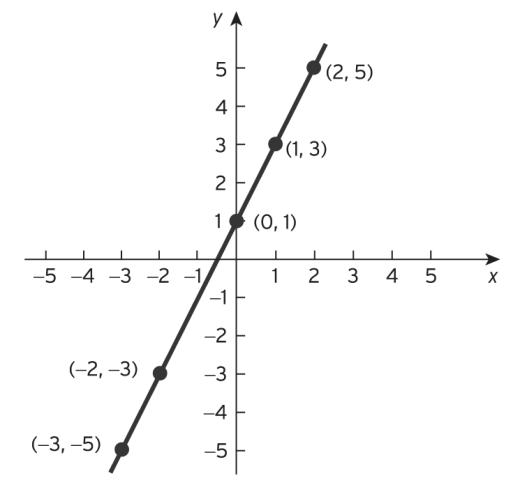
Practice Problems
1. From Figure S1.1, note that all five points lie on a straight line.
The graph is sketched in Figure S1.2.
The graph shows that (3, −1) does not lie on the line. This can be verified algebraically:
+ 3(−1) = 6 − 3 = 3 ≠ 4
Jacques, Mathematics for Economics and Business, 9e, Instructor’s Manual 13
Education
© Pearson
Limited 2018
Figure S1.1
Point Check (−1,2) 2(−1) + 3(2) = −2 + 6 = 4 ✓ (−4,4) 2(−4) + 3(4) = −8 + 12 = 4 ✓ (5, −2) 2(5) + 3(−2) = 10 − 6 = 4 ✓ (2,0) 2(2) + 3(0) = 4 + 0 = 4 ✓
2.
2(3)
Figure S1.2
3. 324
3(2)24(substitute 2)
624
22(subtract 6 from both sides)
1(divide both sides by 2)
Hence (2, 1) lies on the line.
324
3(2)24
624(substitute 2) 210(add 6 to both sides)
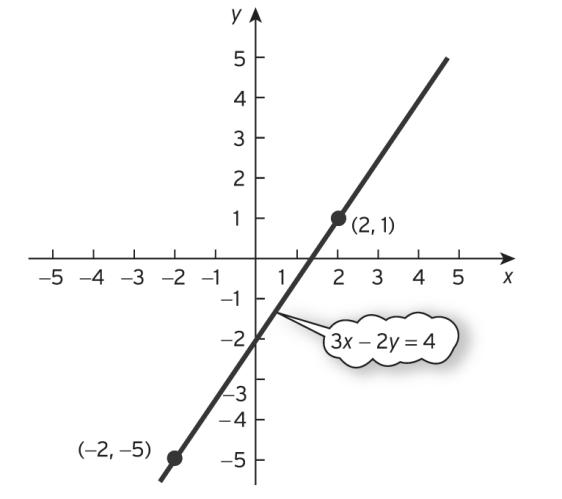
5(divide both sides by2)
Hence (−2, −5) lies on the line.
The line is sketched in Figure S1.3.
4. 22xy−=
022(substitute 0) 22
−== −= =−−
yx y y
1(divide both sides by 2)
Hence (0, –1) lies on the line. 2 2
xy xy x x
−= −== −= =
2(0) 2 (substitute 0) 0 2 2
Hence (2, 0) lies on the line.
Jacques, Mathematics for Economics and Business, 9e, Instructor’s Manual 14
© Pearson Education Limited 2018
xy yx y y y −= −== −= −=− =−
xy y yx y y −= −−= −−==− −= =−−
Figure S1.3
The graph is sketched in Figure S1.4.
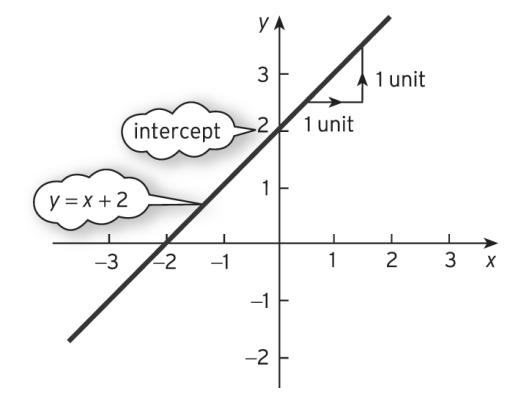
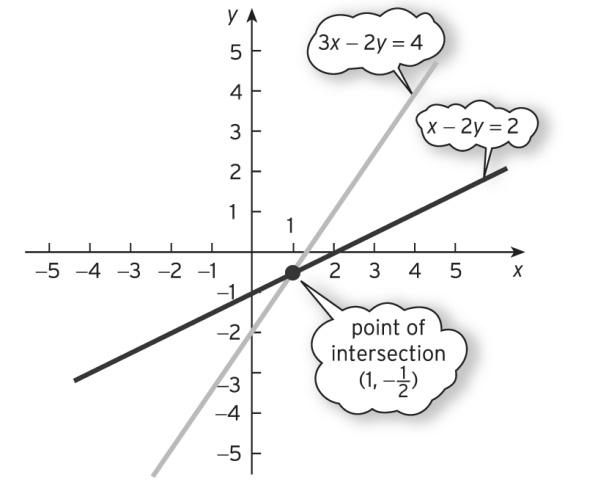
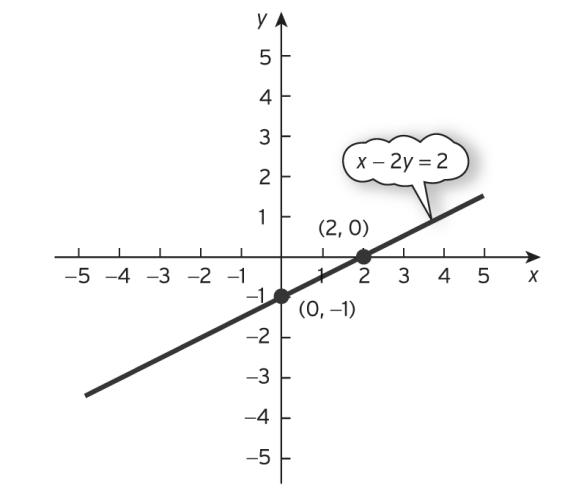
6. (a) a = 1, b = 2. The graph is sketched in Figure S1.6.
© Pearson Education Limited 2018
Jacques, Mathematics for Economics and Business, 9e, Instructor’s Manual 15
Figure S1.4
5. From Figure S1.5, the point of intersection is (1, −½).
Figure S1.5
Figure S1.6
421
(b) 1 2 1 2
214(subtract 4 from both sides)
2(divide both sides by 2) so 2, . The graph is sketched in Figure S1.7.
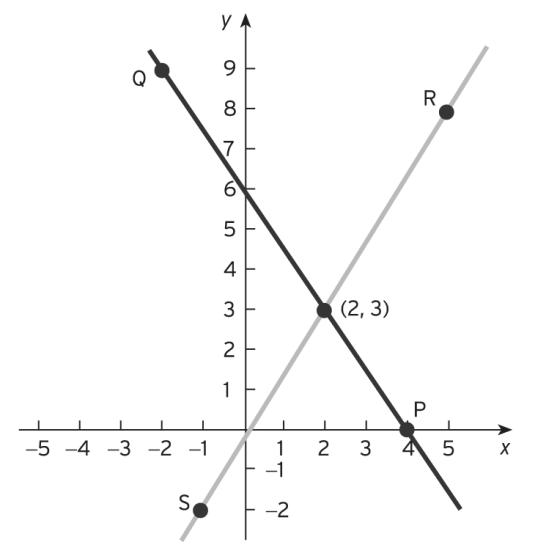
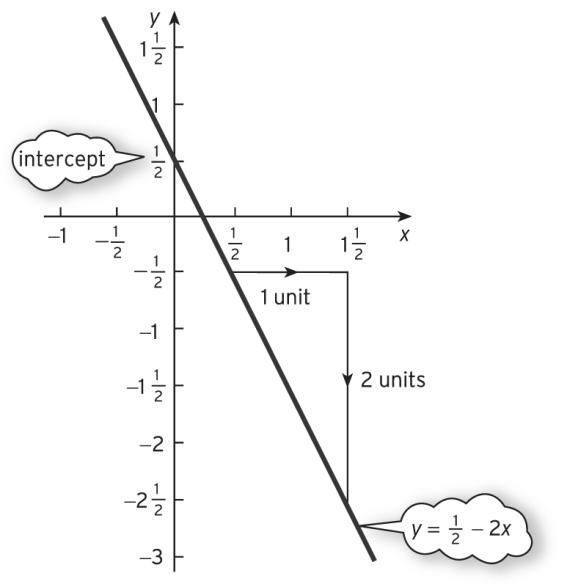
Exercise 1.3 (p. 52)
© Pearson Education Limited 2018
Jacques, Mathematics for Economics and Business, 9e, Instructor’s Manual 16
xy yxx yx ab += =− =− =−=
Figure S1.7
1. From Figure S1.8, the point of intersection is (2, 3).
Figure S1.8
2 (a) The graph is sketched in Figure S1.9.
(b) (i) $540 (ii) 2500 km
3. A,C,D,E
4. (a) 3108 x −=



318 x = (add 10 to both sides)
x = 6 (divide both sides by 3)


(b) 358 y −=
55 y −= (subtract 3 from both sides)
1 y =− (divide both sides by 5 ) (6,2),(1,1).
5. x y
Jacques, Mathematics for Economics and Business, 9e, Instructor’s Manual 17
© Pearson Education Limited 2018
Figure S1.9
8 6 0 3 4
0
The graph is sketched in Figure S1.10.
6. (a) The line 22 xy −+= passes through (0, 2) and (−1, 0)
The line 26 xy+=− passes through (0, −6) and (−3, 0)
The point of intersection has coordinates (–2, –2)
(b) The line 3412 xy+= passes through (0, 3) and (4, 0)
The line 48xy+= passes through (0, 2) and (8, 0)
The point of intersection has coordinates (2, 1 1 2 )
(c) The line 24 xy+= passes through (0, 4) and (2, 0)
The line 433 xy−= passes through (0, −1) and (3/4, 0)
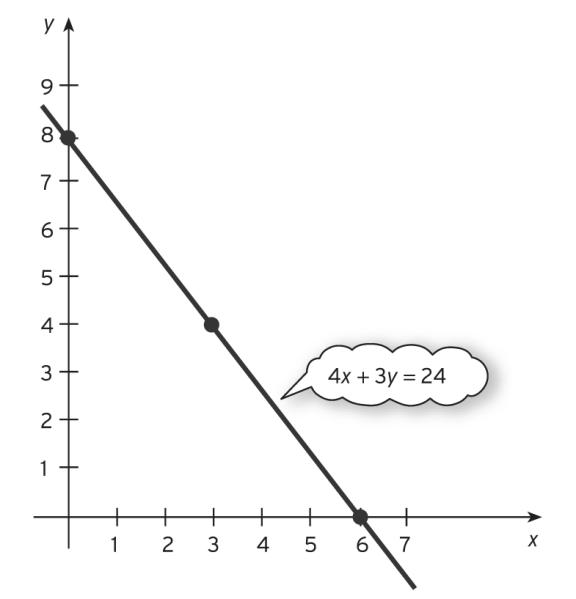
The point of intersection has coordinates (1 1 2 , 1)
(d) The line 1 xy+= passes through (0, 1) and (1, 0)
The line 6515 xy+= passes through (0, 3) and (5/2, 0)
The point of intersection has coordinates (10, –9)
7. (a) 5, 9 (b) 3, 1 (c) 1,13
(d) 4 xy −+= 4 yx=+ (add x to both sides)
so the slope is 1 and the y-intercept is 4
© Pearson Education Limited 2018
Jacques, Mathematics for Economics and Business, 9e, Instructor’s Manual 18
Figure S1.10
(e) 425 xy+=
245 yx=−+ (subtract 4x from both sides)
5 2 2 yx=−+ (divide both sides by 2)
so the slope is 2 and the y-intercept is 5 2
(f) 56 xy−=
56yx −=−+ (subtract 5x from both sides)
56yx=− (divide both sides by 1)
so the slope is 5 and the y-intercept is 6
8. (a) The line has a slope of 1 and a y-intercept of 0. The line passes through the origin and for every one unit along the graph goes down 1. The graph is sketched in Figure S1.11.
(b) 26xy−=
26 yx −=−+ (subtract x from both sides)
1 3 2 yx=− (divide both sides by –2)
so the line has a slope of 1/2 and a y-intercept of 3
The line passes through the point (0,3) and for every unit along the graph goes up by 1/2 unit, or equivalently, for every 2 units along it goes up by 1 unit.
The graph is sketched in Figure S1.12.

Jacques, Mathematics for Economics and Business, 9e, Instructor’s Manual 19
© Pearson Education Limited 2018
Figure S1.11





Jacques, Mathematics for Economics and Business, 9e, Instructor’s Manual 20
2018
© Pearson Education Limited
Figure S1.12
9. (a) 42.5 Cx =+
(b) The graph is sketched in Figure S1.13.
and
Download: http://testbanktip.com/download/mathematics-for-economics-and-business-9th-edition-jacques-solutions-manual/ Download all pages and all chapters
Figure S1.13
Mathematics for Economics
Business Full





















